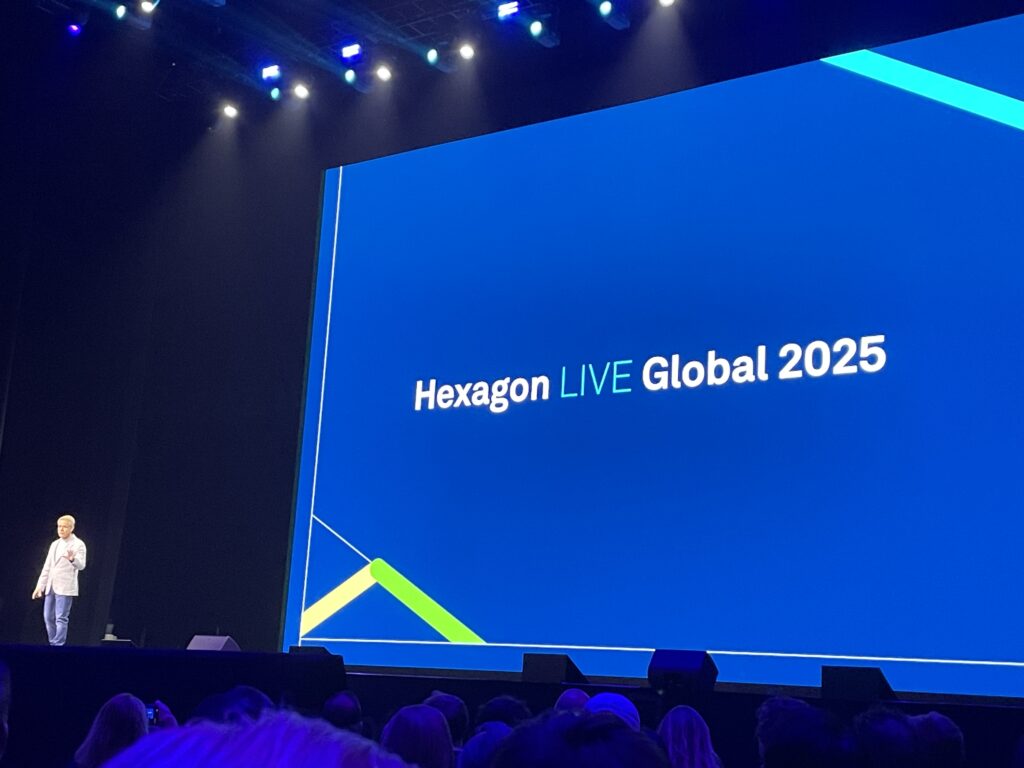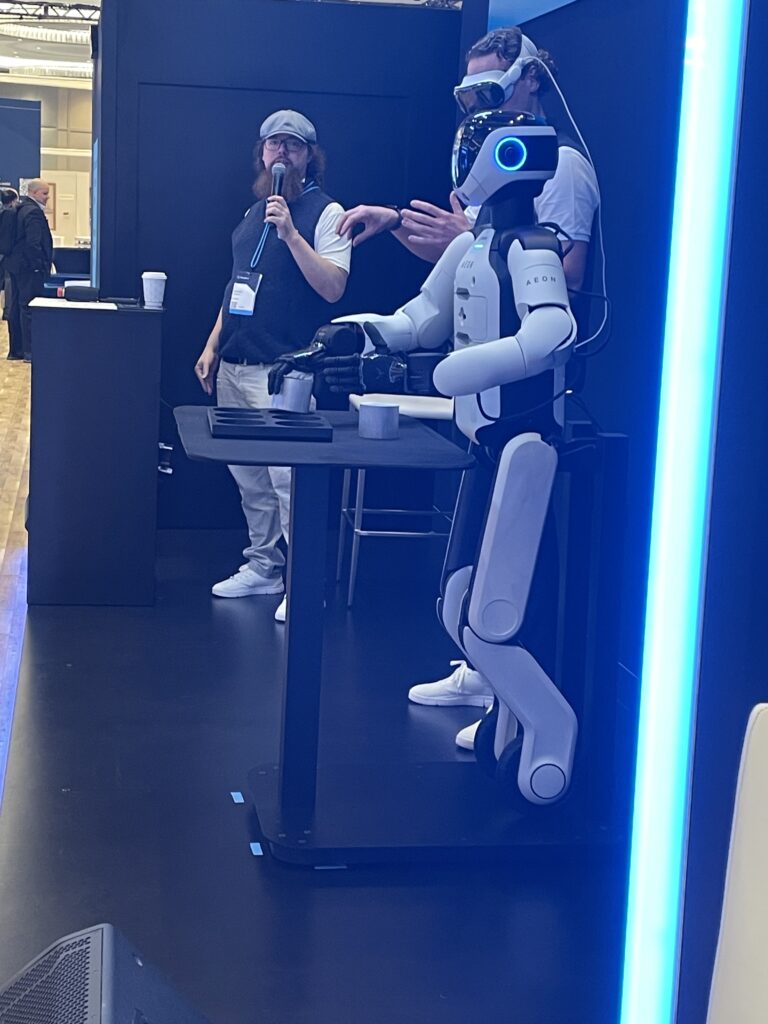There are several trends shaping the future of manufacturing in 2025, including supply chain resilience, workforce development and management, sustainability, and the adoption of cutting-edge technologies like AI, automation, and additive manufacturing. At last month’s Hexagon Live in Las Vegas, I spoke with Jason Walker, General Manufacturing Practice Lead for Hexagon Manufacturing Intelligence, about several of these trends.
Manufacturing Tariffs
We started our conversation by talking about tariffs—a topic that’s nearly impossible to avoid these days. During the event, Hexagon shared the results of its “Americas State of Manufacturing 2025 Report,” which surveyed 500 professionals from the manufacturing industry. Walker told me that the U.S.-based respondents did find tariffs concerning, since they don’t know for sure how their businesses will be impacted. But, he also said that “the overall sentiment is still positive.”
“More than 50% of manufacturers are still optimistic for their futures and their opportunities in the manufacturing space,” he said.
Walker said that tariffs being implemented on parts and production coming into the U.S. should drive more of an onshoring initiative, which is a good thing. But, he also noted that “most manufacturers realize as well that the ramp-up phase is much longer than is probably going to be needed” to solve any supply chain issues resulting from tariffs. So there are a lot of mixed feelings, which is pretty consistent with every other conversation I’ve had about tariffs in the manufacturing industry.
“I don’t think anybody’s certain on what this is going to mean for the industry going forward. There’s no conclusive answers there,” Walker said, calling it a “wait and see” situation.
Technology and the Skills Gap
What does keep coming up as more of a concern, from larger OEMs down to the smaller supply chain manufacturers, is the skills gap.
“When it comes to bridging the skills gap, manufacturers are realizing that to attract new talent in the workforce, and new skills, they need to enhance the tools and technology they use as well,” Walker said. “Often, the industry is still seen as this dull, dirty, dangerous place, with a lot of manual operations and a lack of technology adoption. That’s something that we’ve heard from our customers, and manufacturers in general: they realize they need to enhance the types of technology that they have, which has a twofold effect.”
The first in this twofold effect is using new technologies to bridge the skills gap and reduce the burden on the current workforce. For instance, automation can take over some of the more tedious manual tasks, so workers can instead focus on bigger challenges. Secondly, new technologies can help optimize how manufacturing operations are run. Walker mentioned “tribal knowledge,” which has been built up by the skilled workforce over many years and is focused on the manual, everyday tasks. Bringing in solutions like AI, automation, and additive manufacturing can streamline operations.
I brought up AEON, the humanoid robot Hexagon launched at the event that’s meant to complement the workforce, working alongside humans to take on those tedious tasks. Walker said solutions like that “definitely have a part to play.”
“If we look at our traditional technologies as well, and how we’re enhancing them with the likes of AI technology, it really is to reduce the burden on existing operations.”
He cited ProPlanAI, a programming tool launched last year by Hexagon Manufacturing Intelligence. This AI capability within CAD/CAM production software makes it much quicker to take a part’s design and make it production-ready. It’s also been applied to Hexagon’s other production solutions, such as Metrology Mentor software, where it makes machine preparation easier and “reduces the need for CAM and metrology operators to just sit in front of a PC programming parts and inspection routines.”
Hexagon’s Additive Manufacturing Suite
I asked how AM fits into Hexagon’s plan to reduce the burden on the workforce, and Walker brought up the company’s Additive Manufacturing Suite, which facilitates the entire AM process from initial quote to delivery. Users can manage the design and everything else in one interface.
“Like I just mentioned for ProPlanAI, where you’re preparing a part for a machining process on a CNC machine, likewise with additive, we can see that application being applied to make it quicker and easier to generate the programs for 3D printing applications as well,” he explained.

Mathieu Perennou, Director Global Strategy & Business Development, Additive Manufacturing, Hexagon Manufacturing Intelligence
In a separate conversation, I was lucky enough to get a rundown of Hexagon’s AM Suite from Mathieu Perennou, Director of Global Strategy & Business Development, Additive Manufacturing.
“When talking about AM Suite, or our additive manufacturing capabilities, or really any manufacturing process, think of the workflow you’re covering,” he said. “What you start with is you have to design your product. Then you need to figure out how you’re going to actually manufacture the product, and then you will in fact manufacture it. And then you need to check whether your product is meeting the quality requirements. You’re gonna inspect the parts, and you know that if the process parameters change, then the material you make is different. So it’s very important in additive manufacturing, the quality inspection, because there is still a relative lack of maturity in additive manufacturing.”
Perennou explained that while AM does make good parts, our experience with the technology is much less than with conventional manufacturing methods that have been around for hundreds of years. But, for those who want to “fast-track things,” artificial intelligence and machine learning then come into play, especially in the quality inspection side of things.
“How do you capitalize and leverage the data that you gather in quality inspection so that you can assess faster, quicker, and earlier the quality of the parts you make? Hexagon has solutions all along that workflow.”
So Hexagon’s AM Suite connects all those different pieces of the workflow. MSC Apex Generative Design, for example, is where you can make complex shapes, placing material exactly where it’s needed for something like a challenging aerospace application.
“You define and create the forces, you give a target, and say, this part needs to be able to take that level of stress,” Perennou explained. “So you give a stress target, and then, once you’ve done that, now that you have all the boundary conditions and the targets, the software will automatically calculate a shape that will meet these requirements. You start the optimization, and it takes the original design space, and it will remove material, and every shape the software creates, it calculates whether it meets your requirements. And eventually we will propose an ultimate shape based on all the criteria for the optimization that you gave.”
Just like its name suggest, Simufact Additive is where you can go to simulate your print job. Perennou said that this product takes “the geometry with the orientation, with the supports, plus the process parameters, and say, okay, if I put all of that together with a material, am I making a good part or not?” AM STUDIO is build preparation software, and finally there’s the AI-driven ESPRIT EDGE. Everything is connected together through Nexus, an agnostic platform that allows you to use third-party solutions if you want.
Opportunities
Even though, as Walker said, AM was once hyped a lot, Hexagon sees many real-world applications for the technology, especially in supporting the production of unique one-off parts that can be used in mass production, such as jigs and fixtures and other workholding.
“If you need to manufacture a thousand parts and you need a specific workholding for a unique geometry or something like that, then additive is the best way to achieve that in a short space of time and create that one-off workholding,” he said.
In late 2024, Hexagon also finalized the acquisition of Geomagic software from 3D Systems, and sees a big opportunity here to expand its reverse engineering capabilities, like Geomagic’s Design X solution, for manufacturers focused on additive, and integrate this software into Additive Manufacturing Suite.
“So it’s creating more of a unique, or holistic, suite of solutions,” Walker explained.
I asked if Hexagon has any more acquisitions planned, and he says the company is “always looking at more complementary technologies,” though he’s not sure of any “imminently on the radar.” But the company obviously has teams specifically dedicated to those kinds of decisions.
“We have both our product teams working on what else we need in terms of technology and capabilities, and then a full M&A team who’s focused on going and looking for some of those,” he said. “I have no doubt there will be more.”
Walker said overall, Hexagon is very optimistic about the state of things.
“The manufacturing industry still has so much opportunity to be enhanced, and become more efficient and productive through the use of some of the advanced technologies we have to provide,” he concluded. “We’re actively focusing on how we can enhance all of these solutions with the likes of AI, automation, robotics, et cetera.”






